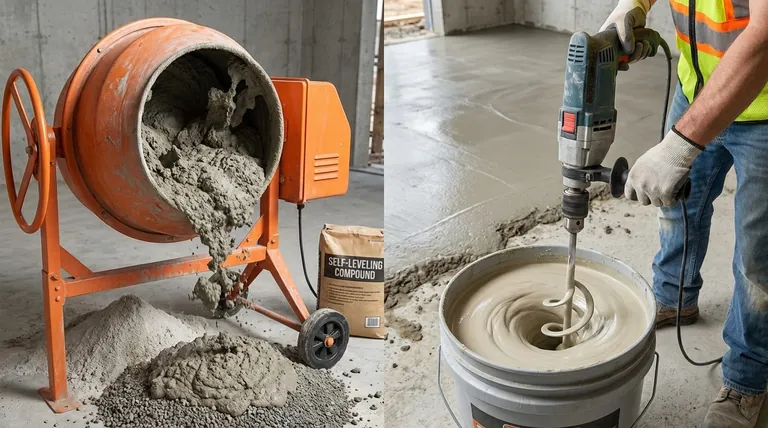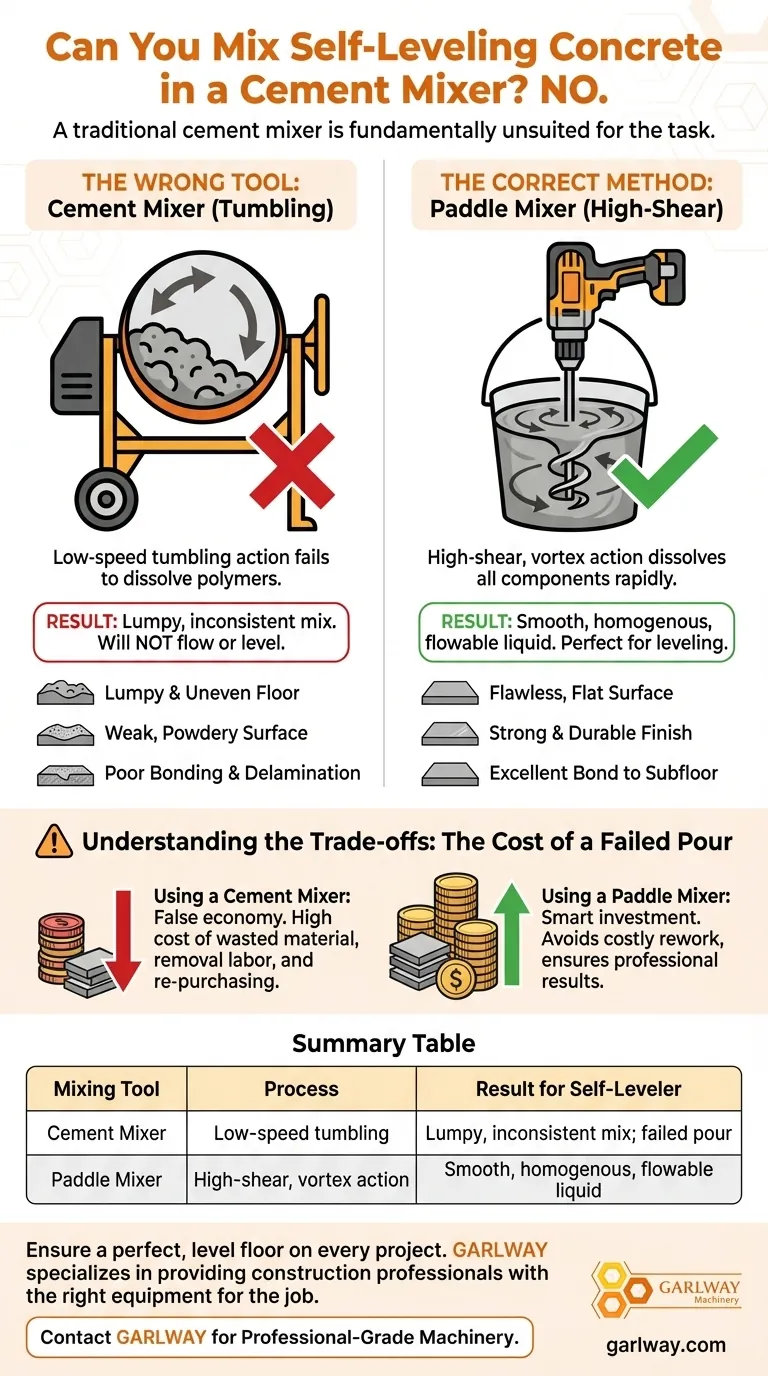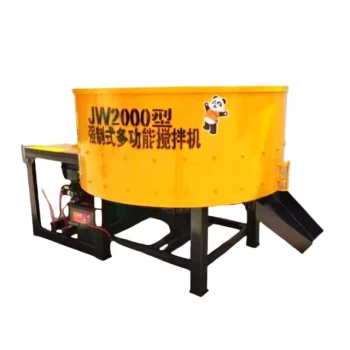No, you cannot use a standard cement mixer for self-leveling concrete. A traditional cement mixer, which tumbles materials at a low speed, is fundamentally unsuited for the task. Self-leveling compounds require an intense, high-shear mixing action to properly dissolve all chemical components and achieve the necessary smooth, flowing consistency for a successful pour.
The core issue is the difference between tumbling and high-shear mixing. A cement mixer tumbles materials, which is adequate for traditional concrete, but self-leveler requires a vigorous, blender-like action to activate its polymers and create a lump-free, liquid state. Using the wrong tool will almost certainly result in a failed application.

Why a Cement Mixer is the Wrong Tool
The Problem of Low Speed and Shear
A standard cement mixer works by lifting and dropping the material, a process known as tumbling. This is effective for combining sand, aggregate, and cement into a coarse mixture.
Self-leveling compounds, however, contain complex polymers and very fine powders. These ingredients need to be dispersed rapidly and evenly in water, which can only be achieved with a high-speed, high-shear mixing action. This is the same principle as trying to mix a protein shake; stirring with a spoon leaves clumps, while a blender creates a smooth liquid.
The Inevitable Result: A Failed Mix
When you use a cement mixer, the self-leveling compound will not be mixed properly. The result is a lumpy, inconsistent slurry that will not flow correctly or level itself out.
This incomplete mixing leads to weak spots in the final floor, an uneven finish, and poor bonding with the subfloor. The very properties that make the product "self-leveling" are never activated.
The Correct Method for Mixing Self-Leveler
The Essential Tool: The Paddle Mixer
The industry-standard tool for this job is a heavy-duty, low-speed/high-torque drill equipped with a paddle mixer attachment (often called a "spiral" or "helix" mixer).
This combination creates a vortex in the bucket, forcing the powder and water to combine rapidly and completely. It provides the high-shear energy needed to dissolve all components into a homogenous, flowable liquid.
The Proper Technique
Always follow the manufacturer's instructions precisely, but the general process is consistent:
- Pour the pre-measured amount of clean, cool water into a mixing bucket first.
- Turn on the paddle mixer and slowly add the bag of self-leveling powder.
- Mix continuously for the time specified in the instructions, typically 2-3 minutes.
- Ensure the paddle moves around the bottom and sides of the bucket to incorporate all the material.
Understanding the Trade-offs
The False Economy of Using the Wrong Tool
It is tempting to try and use a tool you already own, like a cement mixer, to save time or the cost of a rental. This is a critical mistake.
The cost of a failed pour—including wasted material, the difficult labor of removing the bad product, and purchasing new materials—is exponentially higher than the cost of renting or buying the correct paddle mixer.
The Consequences of a Bad Mix
An improperly mixed self-leveler will not perform its function. You will be left with a surface that is:
- Lumpy and Uneven: The opposite of the intended result.
- Weak and Powdery: The material may never cure to its specified strength.
- Poorly Bonded: The topping can delaminate from the subfloor over time.
Making the Right Choice for Your Project
- If your primary focus is a small patch or repair: A high-quality corded drill and the correct paddle attachment are non-negotiable for achieving a professional result.
- If your primary focus is a large floor area: Dedicate one person solely to mixing in batches with a paddle mixer to ensure a consistent and continuous pour for the installation team.
- If your primary focus is saving money: The most cost-effective path is to use the correct tool from the start, avoiding the significant expense and labor of fixing a failed application.
Ultimately, respecting the material's chemical requirements by using the right mixing process is the only way to guarantee a smooth, flat, and durable surface.
Summary Table:
| Mixing Tool | Process | Result for Self-Leveler |
|---|---|---|
| Cement Mixer | Low-speed tumbling | Lumpy, inconsistent mix; failed pour |
| Paddle Mixer | High-shear, vortex action | Smooth, homogenous, flowable liquid |
Ensure a perfect, level floor on every project.
Mixing self-leveling concrete correctly is critical to its performance. GARLWAY specializes in providing construction professionals with the right equipment for the job. Our range of heavy-duty drills and paddle mixers delivers the high-shear action needed for flawless results.
Don't risk a failed pour and costly rework. Contact GARLWAY today for reliable machinery that guarantees professional-grade finishes for your construction projects.
Visual Guide

Related Products
- HZS75 Concrete Batching Plant Cement Mixer Price Concrete Mixer Bunnings Mixing Plant
- JZC1000 Industrial Concrete Mixer Machine Cement Mixer Price
- Auto Concrete Cement Mixer Machine New
- Concrete Cement Mixer Machine Drum Mixer for Construction
- JDC350 Small Cement Concrete Mortar Mixer
People Also Ask
- How do I choose a cement mixer? Find the Perfect Match for Your Project Scale and Power Needs
- What are the disadvantages of ready mixed concrete? Navigate Logistical & Cost Risks
- What can you mix in a cement mixer? Unlock Its Full Potential for Concrete & Beyond
- Do you put water or cement in a cement mixer first? Master the Professional Layering Method
- Can you mix mortar in a cement mixer? Avoid weak joints and project failure.



















